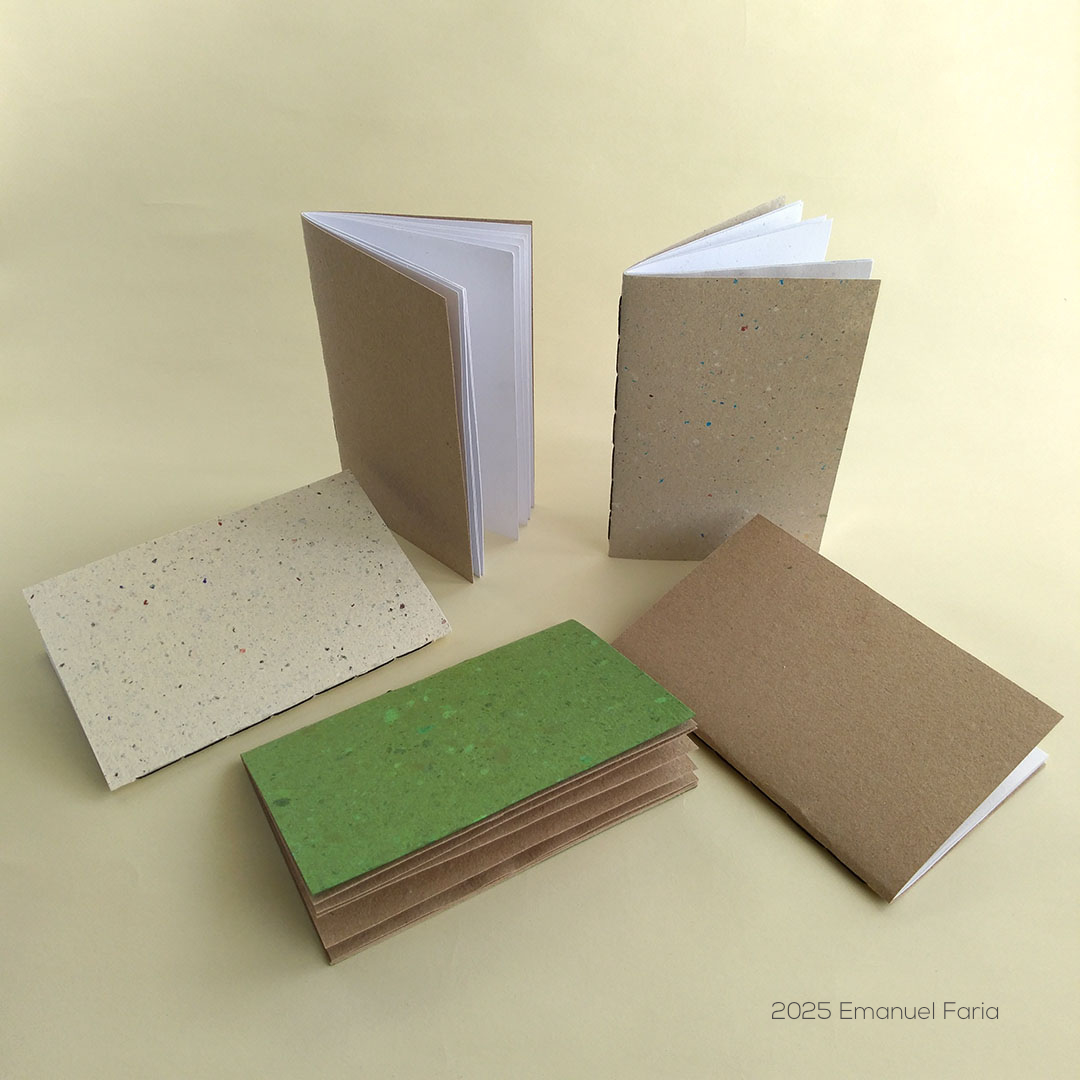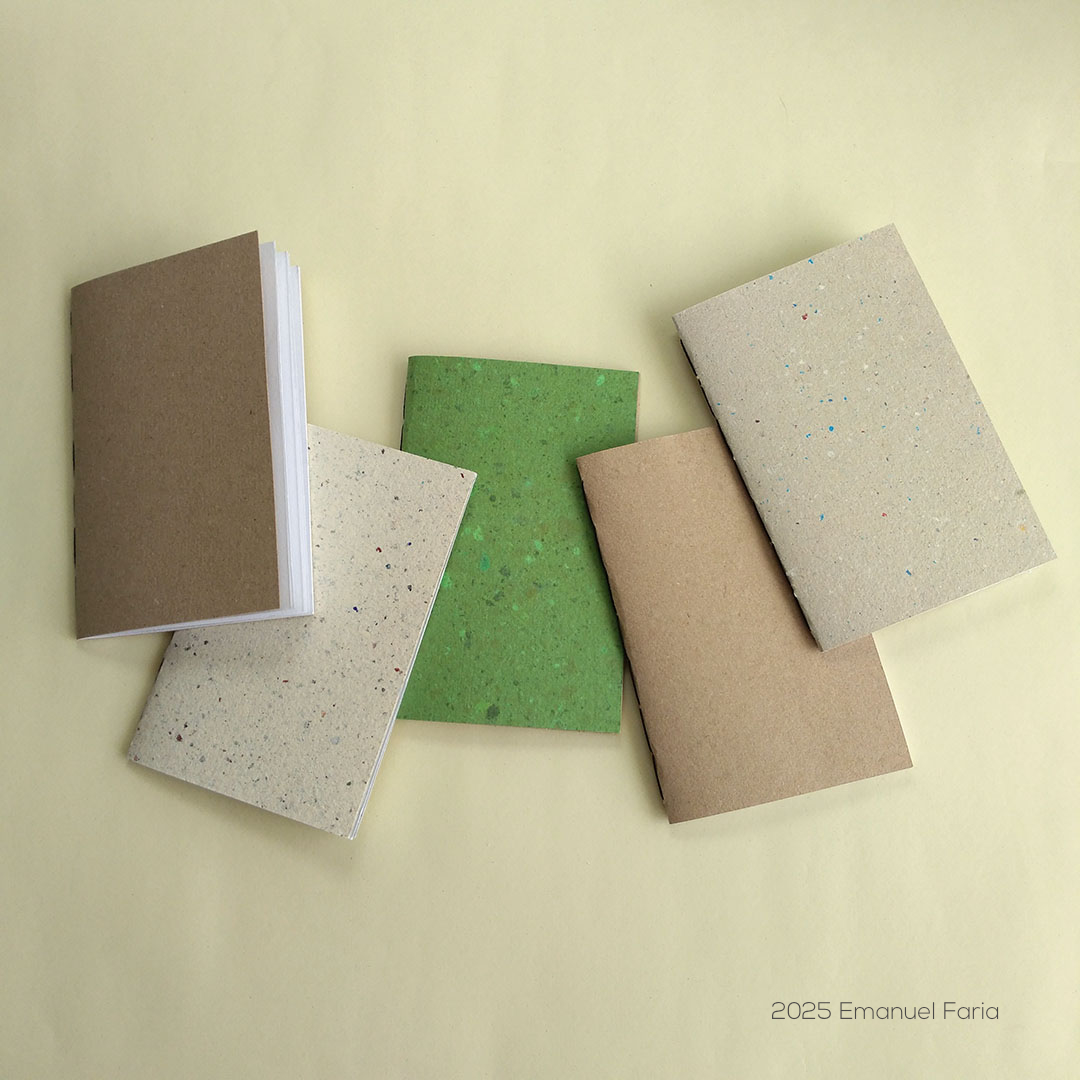Shaping a circular industrial ecosystem and supporting life-cycle thinking
Bio Banana Notebook
Biological Banana Notebook
The Bio Banana Notebook is a simple notebook made by hand using only the matter leftover from the banana fruit production, to make the cover, the pages, the ink for the lines, and the string to join all in a notebook that is safely biodegradable or compostable in your home garden.
Portugal
Regional
Madeira island
Mainly rural
It refers to a physical transformation of the built environment (hard investment)
Early concept
No
No
As an individual
The project recognized that banana production creates a lot of leftover matter that is left on the fields to dry or is sent to landfill, this matter is a valuable biological material that can be used on a circular product system before it returns to the fields again as compost for new life. In Madeira island, the region where the project is being developed. It is produced annually an average of 20 tons of banana fruit, being the number of tons of leftovers superior. This matter, banana stems, leaves, and banana peels all can be used to make sustainable paper, textiles, and inks. The objective of this project is to bring all these materials together to create a sustainable alternative pocket notebook to take notes, draw, and much more. The product can promote a sustainable region ecosystem of notebooks that are used, reused, recycled, and at the end of life composted and returned to the soil to refurbish new life. The notebooks can be used by all locals as tools for creativity, for taking and keeping simple notes, and as a promotion product/gift for tourism, as is one of the main economic drivers on the island. It will create a local and renewable production, in a region where all those products are imported nowadays. Thus I believe this project is a valid candidate for the category “Shaping a circular industrial ecosystem and supporting life-cycle thinking”
Design
Local
BioMaterials
Biodegradable
Circular economy
The key objective is to create a notebook using only the matter leftovers from the banana biological fruit production (banana stem, leaves, banana peels). A notebook that is made without chemicals, and that is safely composted, and biodegradable in nature.
The notebook will be created using friendly artisanal techniques.
The project can be exemplary by showing that is possible to create products with valuable leftovers from regional resources that are sustainable on a local level.
The notebook will be created using friendly artisanal techniques.
The project can be exemplary by showing that is possible to create products with valuable leftovers from regional resources that are sustainable on a local level.
The objective is to create a product with a natural material feeling, which gives the experience and sense of holding an object in the hands made by a local resource so abundant and visible to everyone in the region.
Creating a sense of belonging, a familiar feeling between the person and the object, and a more meaningful, personal relationship between the two.
Can be exemplary by making locals and visitors feel connected with the place through a local product. And reconnect with nature by feeling that the product is part of a circular biological cycle. Having no feelings of environmental guilt by buying and using it. On the contrary, feel good by using such a product.
Creating a sense of belonging, a familiar feeling between the person and the object, and a more meaningful, personal relationship between the two.
Can be exemplary by making locals and visitors feel connected with the place through a local product. And reconnect with nature by feeling that the product is part of a circular biological cycle. Having no feelings of environmental guilt by buying and using it. On the contrary, feel good by using such a product.
The product will be a simple affordable notebook that can be purchased locally and used by everyone, for a large variety of ends, for an artist to draw, a student to take notes, or a local representative to draft his speech, imagination is the limit.
The citizens will benefit by having an option of acquiring a local, biodegradable product to write on, which is a non-existent option nowadays in the region. It will be one more sustainable product in the region and possibly a little less source of waste material (normal paper) that can easily end up in nature and pollute the environment.
They can also contribute to giving one more cycle to the product/material by delivering it back when no longer useful, to be recycled into a new notebook or to become compost for the soil. Another result can also be contributing to a more beautiful and pleasant view of the fields by having less visual pollution.
They can also contribute to giving one more cycle to the product/material by delivering it back when no longer useful, to be recycled into a new notebook or to become compost for the soil. Another result can also be contributing to a more beautiful and pleasant view of the fields by having less visual pollution.
A local banana producer and friend contributed by giving some leftovers for experiments and testing of the concept. In the future, more producers, as the regional entity of banana producers, can be involved, and create one more stream of income for producers by selling their leftovers. Some techniques on how to work with natural fibers were gained in workshops led by local artisans, and in the future, they can contribute even more. Some designers were also involved in the discussion of ideas. All the stakeholders added value by sharing knowledge from their practices, many of them specific to the region's materials characteristics and local techniques. So far all stakeholders were regional, but in further phases of the project will need to collaborate with stakeholders from the national level and probably European level in obtaining certificates of quality, sustainability, among others.
The main disciplines approached for the project were biology, arts and crafts, chemistry, and design. The designer was in the center, connecting all fields. Talking with experts in each field and applying their knowledge and recommendations, to the experiments.
In a further phase of the project, more interaction will happen and would be interesting to have biologists, chemistries, artisans, and banana fruit producers meet to exchange knowledge, recommendations, and ideas. Would be valuable to have a better holistic view of the concept and new ideas.
In a further phase of the project, more interaction will happen and would be interesting to have biologists, chemistries, artisans, and banana fruit producers meet to exchange knowledge, recommendations, and ideas. Would be valuable to have a better holistic view of the concept and new ideas.
Leftovers from banana producers have been used for many years in different parts of the globe. In the Madeira island region, in the past, fibers from banana stems were used to help with agriculture tasks as a small rope to tie small things. Nowadays that tradition is being lost and substituted by other materials such as plastic.
The innovation character is the use of matter only from one source, banana leftovers, which means in the end we have a product made of only one main material and all biologic. Normally notebooks are made of several materials, and even when made of sustainable fibers, can have glues or strings made of different biological origins or even be synthetic, which makes the recycled process difficult and unsafe to compost them.
In this way, not only the notebook is easy to recycle, not demanding any disassembly of components as it is all from the same base material, as well is safely compostable or biodegradable in nature.
The innovation character is the use of matter only from one source, banana leftovers, which means in the end we have a product made of only one main material and all biologic. Normally notebooks are made of several materials, and even when made of sustainable fibers, can have glues or strings made of different biological origins or even be synthetic, which makes the recycled process difficult and unsafe to compost them.
In this way, not only the notebook is easy to recycle, not demanding any disassembly of components as it is all from the same base material, as well is safely compostable or biodegradable in nature.
The methodology used is a research-experiment methodology, mainly based on trying by myself and learning by doing, evaluating the results. We can say an artisan method combined with a Design approach to product development.
The main material of this project is the leftover natural fibers from banana fruit production. All places that have banana production could replicate this project in all aspects. Other places with fruit or vegetable production where a considerable amount of leftover that contains fibers is generated can also adapt the main methodology, technology, and process to replicate a similar project and results.
The project addresses the global challenge of waste management and environmental pollution. As well the air pollution caused by transportation of materials or products over large distances.
By using local raw materials for the production of products for the local economy. Creating a circular local product system and a flow of biological materials means the product doesn’t need to go to a landfill. Instead can be recycled or safely compost, preventing soil contamination.
Encouraging simple and small solutions at a local level can have a big impact at a global level when done by many.
By using local raw materials for the production of products for the local economy. Creating a circular local product system and a flow of biological materials means the product doesn’t need to go to a landfill. Instead can be recycled or safely compost, preventing soil contamination.
Encouraging simple and small solutions at a local level can have a big impact at a global level when done by many.
As I’m writing the next step is to continue testing and developing the process of making the paper, strings, and inks, to join all in a first prototype, planned to be ready in April of 2025.
The next big step is to collaborate with local chemist to ensure all processes are safe, that all remains from the process can be safely reutilized or composted, and that the final product is safe to return to the soil as nutrition for new life.
Then still collaborating with the chemist, move to the next step and send samples/prototypes to a chemistry laboratory to test and get a certified comproving all these characteristics.
Meanwhile will contact local entities, the government, the tourism office, and banana producers representatives to share my project and communicate my interest in collaborating with them to promote the product. (at a local level)
Having all previous steps done. Will need to get a space to produce the product on the scale as demand requires. As well as places to sell the product.
The next big step is to collaborate with local chemist to ensure all processes are safe, that all remains from the process can be safely reutilized or composted, and that the final product is safe to return to the soil as nutrition for new life.
Then still collaborating with the chemist, move to the next step and send samples/prototypes to a chemistry laboratory to test and get a certified comproving all these characteristics.
Meanwhile will contact local entities, the government, the tourism office, and banana producers representatives to share my project and communicate my interest in collaborating with them to promote the product. (at a local level)
Having all previous steps done. Will need to get a space to produce the product on the scale as demand requires. As well as places to sell the product.


